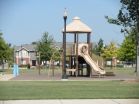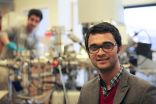(Press-News.org) PROVIDENCE, R.I. [Brown University] -- When the HOPE VI community revitalization project in the disadvantaged Birmingham, Ala., neighborhood of Ensley reached the phase of building walking and biking paths, green spaces, and improved lighting in 2010, two things happened, according to a new study: First, residents developed specific expectations that leisure exercise would become more plausible, and then they followed through and got out there.
Before the neighborhood's revitalization, launched in 2006 with funding from the federal program Housing Opportunities for People Everywhere and other sources, the area was one where going out for a jog or a bike ride was an uninviting if not daunting prospect.
"The community was a very high-crime area and definitely a food desert," said Akilah Dulin-Keita, assistant professor of behavioral and social sciences in the Brown University School of Public Health and lead author of the study in August issue of the journal Social Science & Medicine. "It was unsafe. It was a high-needs community."
Dulin-Keita, then a health researcher at the University of Alabama-Birmingham, not only wanted to measure whether the revitalizations of HOPE VI resulted in residents opting to exercise more but also to elicit and understand the views of the residents that might underlie their response to the project, which had replaced the blighted "Brickyard" housing complex with a new one, Tuxedo Terrace. So before she conducted the statistical survey that confirmed an increase in exercise after revitalization, she led an effort to engage community organizations and residents in documenting and analyzing community perceptions and expectations about the project.
"We really thought it was important to represent their voices in the study and their insights about how they would be influenced," said Dulin-Keita, who teaches a class on urban design and health called "Place Matters." "Being able to ask how they felt and what they expected and then being able to test those things quantitatively can provide insight into why [an intervention] is working."
High hopes and tough realities
In several group discussion sessions at community libraries, Dulin-Keita and her colleagues elicited more than 50 residents' thoughts on the question "How do you think the new Tuxedo housing will affect participation in physical activity?"
In the aggregate of analysis, the statements clustered under a few topics: expectations of increased physical activity (e.g., "there will be a ripple effect because if you see one person out, this will have a positive effect on motivating other people's physical activity"), safe areas to play (e.g., "the new HOPE VI development is well lit, you can go walk and see what is in front/behind you"), and health-promoting resources (e.g., "with the proposed items such as swimming pools, walking tracks, and bike trails, people will become more physically active").
But Dulin-Keita said many of the resident's statements made it clear how difficult the environment was for discretionary, or "leisure," exercise before the change. One resident noted that it would be safe for their kids to play if there were no more broken glass, syringes, or needles, Dulin-Keita recalled. Another resident said, "If you were afraid to go in the Brickyard, now you won't be." She recalled another resident saying, "With the removal of the shrubbery, now you don't have to worry about who's waiting behind the bushes to rob you."
The study quotes another resident who pointed out that increased exercise might not be safer if authorities don't understand the change afoot: "Police should be aware that the physical activity is increasing in the neighborhood so that black males jogging won't be profiled."
Down to the data
The statements informed the design of Dulin-Keita's quantitative survey, conducted with 120 people both before the walking and biking trails were built and again six months later, after they were in place. There, she asked about changes in perception of the neighborhood and whether or not people said they were engaging in more leisure physical activity.
In different versions of the statistical analysis, residents' senses of improved neighborhood walkability and of personal physical safety were associated with increases in physical activity at the six-month followup. A sense of improvement in "neighborhood disorder" (less graffiti, fewer abandoned buildings, and less general crime), however, did not predict increased physical activity.
Although Dulin-Keita moved from Alabama to Rhode Island in 2012, she said she would still like to continue working in Ensley to track whether community norms related to exercise have changed and to make more precise measurements of physical activity, replacing self-reports with wearable accelerometers.
INFORMATION:
In addition to Dulin-Keita, other authors on the study are Olivio Clay, Shannon Whittaker, Lonnie Hannon, Ingrid Adams, Michelle Rogers, and Kim Gans.
The Centers for Disease Control and Prevention (1-U48-DP-001915) and the National Institutes of Health (T32DK062710, R00-DK83333) funded the research.
A vaccine that protects against a wide variety of influenza viruses (a so-called universal flu vaccine) is a critical public health goal given the significant rates of illness and death caused by seasonal influenza and the potentially devastating effects of a pandemic influenza strain. Now, researchers from the National Institute of Allergy and Infectious Diseases (NIAID), part of the National Institutes of Health, have devised a way to induce protective immunity in mice against a wide array of influenza viruses.
Instead of trying to predict which influenza virus strains ...
This news release is available in German. In 2003, Europe experienced a record-breaking summer, and many people feel that this summer is headed the same way. In the midst of this heatwave, the scientific journal Nature Geoscience has published a study that can help us to understand such extreme weather conditions. For around two years, an ETH research team has analysed climate data from all over the world in a bid to explain the driving force behind stable high-pressure systems. It has long been known that extremely stable high-pressure systems in the upper troposphere, ...
Researchers at the Babraham Institute and Cambridge Systems Biology Centre, University of Cambridge have shown that yeast can modify their genomes to take advantage of an excess of calories in the environment and attain optimal growth.
The ability to sense environmental nutrient availability and act accordingly is a critical process for all organisms. Changing behaviour in response to nutrients can occur at many levels: the activity of proteins can be varied or new genes can be activated to produce a different set of proteins. Research published in the latest issue of ...
A majority of men who have sex with men (MSM) and transgender women (TGW) at high risk for HIV infection took anti-HIV medication for pre-exposure prophylaxis (PrEP), most of the time, in a multi-site U.S. study examining use of this HIV prevention strategy outside of a clinical trial. The study, called the PrEP Demo Project, was funded by the National Institute of Allergy and Infectious Diseases (NIAID), part of the National Institutes of Health.
The study findings will be presented by Albert Liu, M.D., of the San Francisco Department of Public Health, at the 8th International ...
Children born with ADNP-related autism syndrome suffer from a heart-breaking combination of ambiguous developmental problems injurious to both their physical health and cognitive functioning. For parents, the mystery surrounding their infants' suffering can be even more agonizing than the syndrome itself, which has no known cure.
Recent research from Tel Aviv University and the University of Antwerp is easing some of that agony. Activity-dependent neuroprotective protein (ADNP), discovered by TAU's Prof. Illana Gozes 15 years ago, has now been shown by Prof. Frank Kooy ...
One of the enduring mysteries of the human experience is how and why humans moved from hunting and gathering to farming.
From their beginnings humans, like other mammals, depended on wild resources for sustenance. Then between 8,000 and 12,000 years ago, in a transitional event known as the Neolithic Revolution, they began to create and tend domestic ecosystems in various locations around the world, and agriculture was born.
Despite decades of research into this major human advancement, scientists still don't know what propelled it.
The recent work of a research ...
WASHINGTON, DC - July 21, 2015 - Each year, scientists create an influenza (flu) vaccine that protects against a few specific influenza strains that researchers predict are going to be the most common during that year. Now, a new study shows that scientists may be able to create a 'universal' vaccine that can provide broad protection against numerous influenza strains, including those that could cause future pandemics. The study appears in mBio, the online open-access journal of the American Society for Microbiology.
"The reason researchers change the vaccine every year ...
WASHINGTON -- Advertisers hoping to sway consumers might want to rethink running spots within media with violent or sexual themes, and might do better if the ads themselves have a G-rating, according to a study published by the American Psychological Association. Instead, violent and sexual media content may impair advertising's effectiveness and ultimately deter purchasing, the research found.
"We found almost no evidence that violent and sexual programs and ads increased advertising effectiveness," said Brad J. Bushman, PhD, professor of communication and psychology ...
Believe it or not: X-ray works a lot better on rocks than on paper. This has been a problem for conservators trying to save historical books and letters from the ravages of time and fungi. They frankly did not know what they were up against once the telltale signs of vandals such as Dothidales or Pleosporales started to spot the surface of their priceless documents
Now Diwaker Jha, an imaging specialist from Department of Chemistry, University of Copenhagen, has managed to adapt methods developed to investigate interiors of rocks to work on paper too, thus getting a ...
HOUSTON -- (July 21, 2015) - Phosphates artificially added to dairy and cereal products appear to cause bigger spikes in blood phosphorus levels than naturally occurring phosphates, potentially putting harmful stress on kidneys. Too much dietary phosphate stiffens blood vessels, enlarges the heart and is bad for bones, but a new study by Houston Methodist researchers suggests it matters where the phosphates come from.
The scientists' report will appear in the August 2015 issue of the American Journal of Clinical Nutrition (early online).
"The study suggests people should ...

